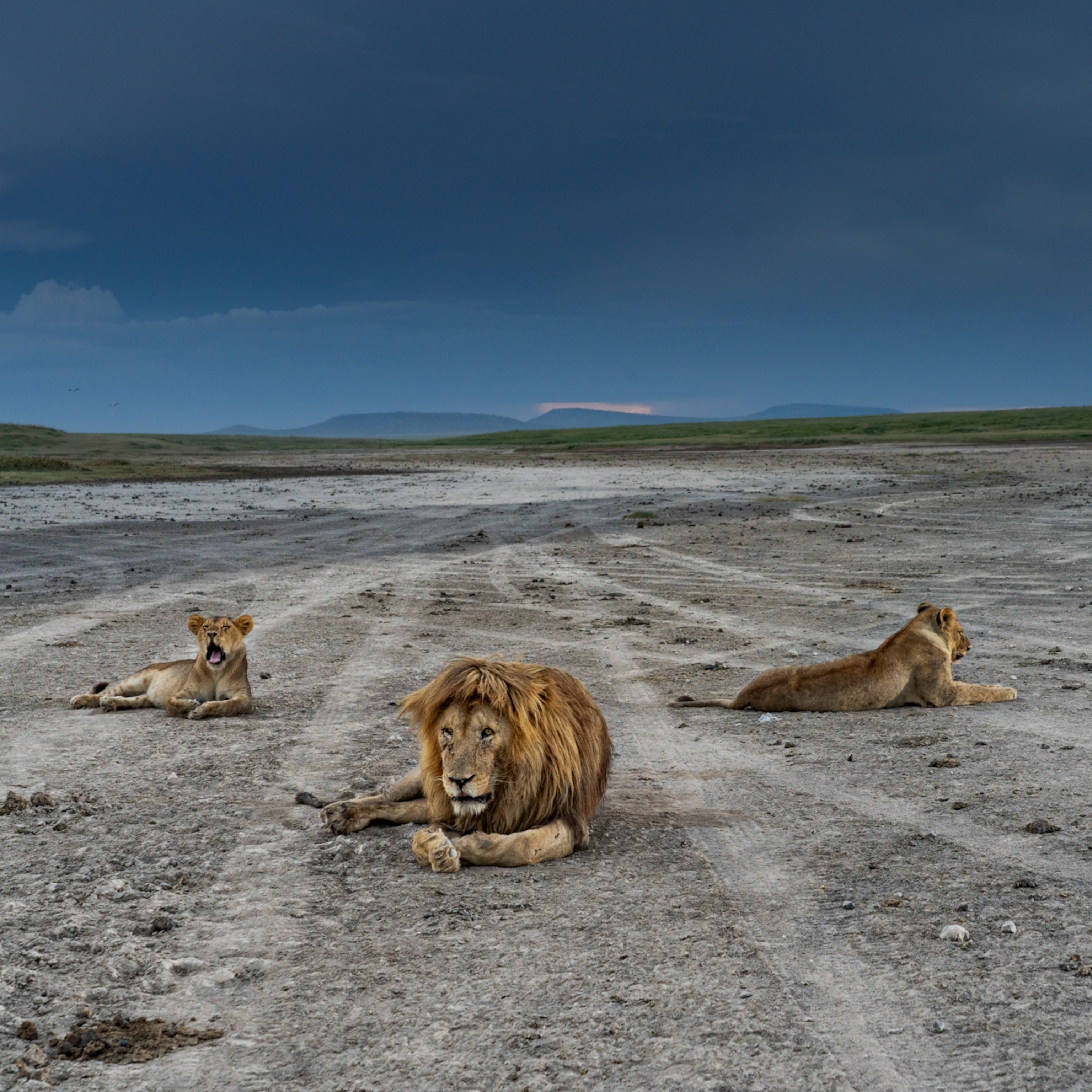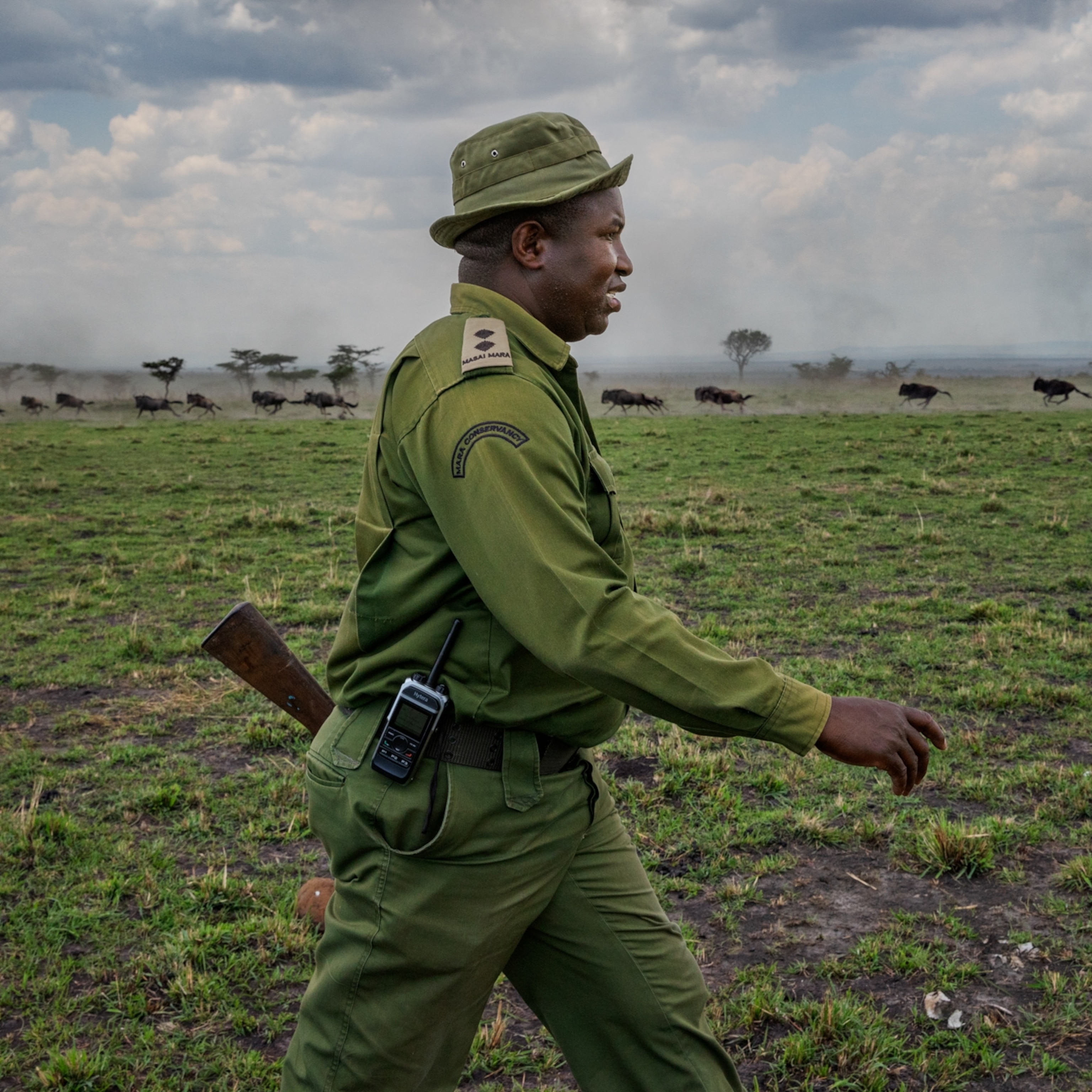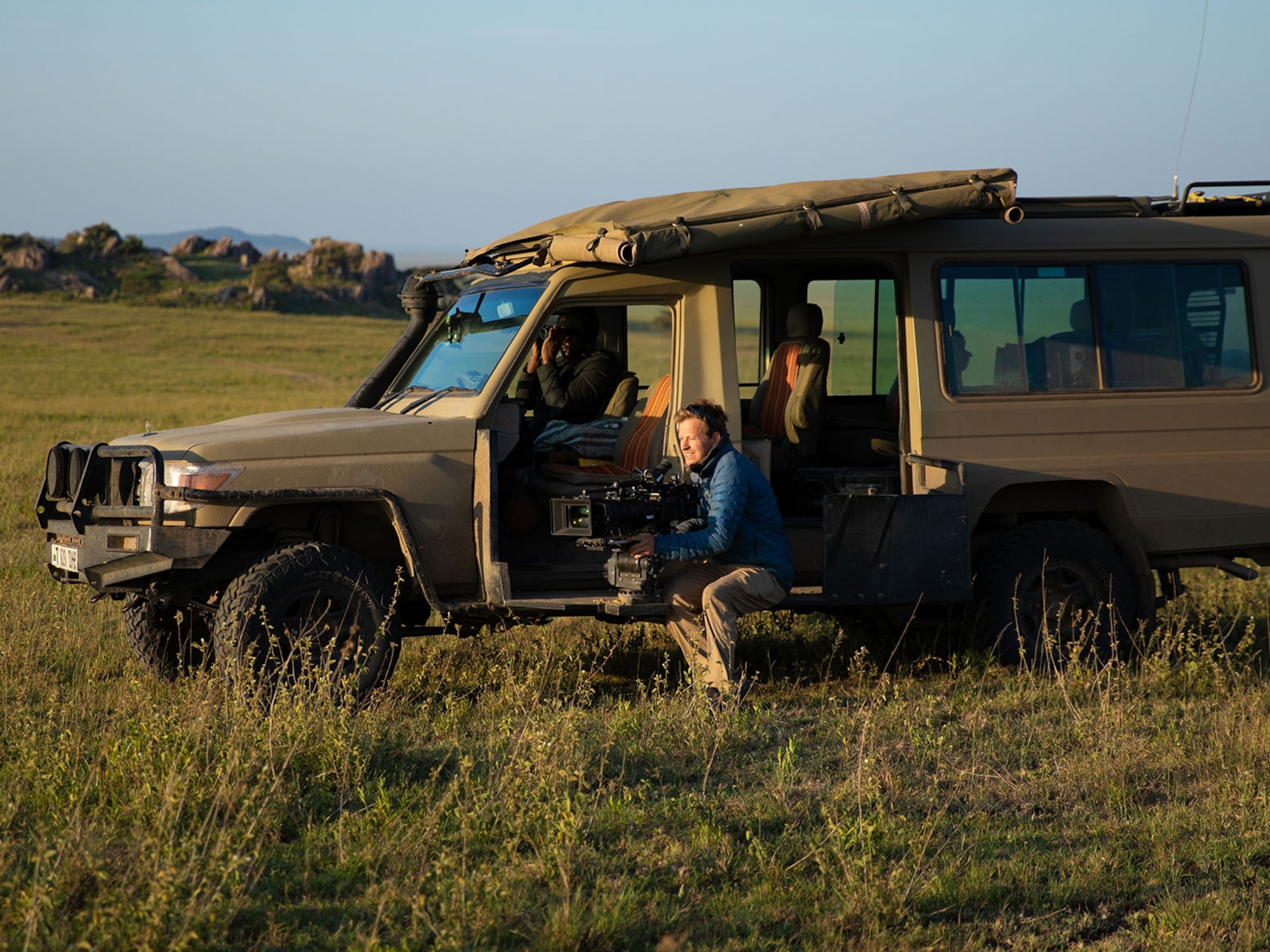
Why the wildebeest is the unlikely king of the Serengeti
The annual migration of this awkward-looking antelope through Kenya and Tanzania drives a complex circle of life.
This is one of five stories that explore the greater Serengeti region and its ecosystem. Read the rest of those stories here.
The line appeared on the horizon as a gray thread on a pale green quilt, but as the plane flew closer, it became a column of a few hundred animals, winding across the plain. “Wildebeest,” Charlie shouted over the drone of the engine. “It’s a small group.” We were north of Tanzania’s Ngorongoro Crater, and since it was March, we knew the wildebeests would soon be moving northwest, up through Serengeti National Park and into Kenya.
And there they were, in a perfectly straight, nose-to-tail convoy. I could make out their curved horns and long heads nodding up and down as they trudged through the morning sun. Several calves pressed against their mothers’ flanks.
For thousands of years, wildebeest herds have journeyed through the greater Serengeti ecosystem in a clockwise circuit—each animal meandering roughly 1,750 miles, the distance from Portland, Maine, to Key West, Florida—following the rains, grazing on the grasses, fertilizing the land, becoming food for the predators. And here, treading the timeless trail of its ancestors, this herd was headed northwest.
But wait, they weren’t headed northwest.
“Why are they going south?” I shouted to Charlie.
“Who bloody knows?” he replied. “They’re looking for grass. Not much to eat here.”
I’d come to Tanzania to see the great migration of wildebeests and joined up with Charlie Hamilton James, who’d been documenting their trek for two years. We’d taken off from Arusha with Mount Kilimanjaro looming on the horizon. The land had unfolded as a sea of luxuriant green hues, a patchwork of coffee farms and stands of dense forest, but after we flew over the crater, the terrain gave way to wide plains, formed by ancient lava flows overlaid with fertile layers of ash from nearby volcanoes. (How volcanic eruptions help nourish the world)
Just a month earlier the area below us had been a carpet of highly nutritious grasses, but the rains had ended, and now, in practically every direction, the ground looked parched, only a whisper of grass. The column of wildebeests seemed like a lost, wandering tribe caught out in the open, an easy target for a lion pride or a family of hyenas.

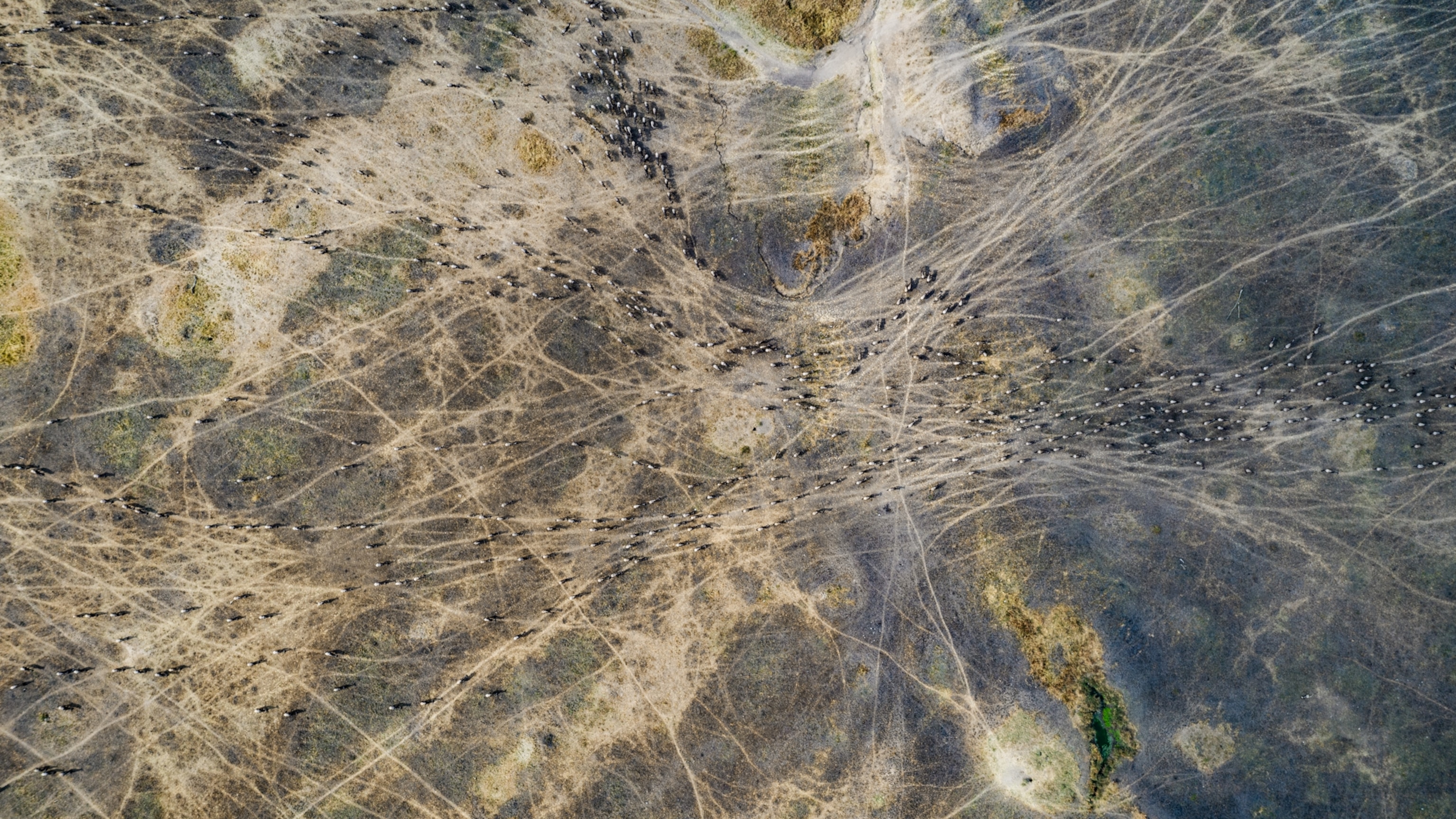
Then I noticed one wildebeest step out of the line. It looked around and started in the opposite direction, as if it had concluded the group was heading the wrong way and had decided to strike out on its own. For a solitary creature, this seemed like certain death. The herd ignored the rebel and ambled on. That wildebeest, I thought, is doomed.
Considering the obstacle course that lay ahead, you’d be right to conclude many of the herd were doomed. They’d be at the mercy of fickle weather patterns, frequently correcting course and traveling long stretches to find fresh grazing. They would be marauded endlessly by predators. In recent years, they’d also had to contend with human impediments—fences built to protect crops and cattle—and competition from burgeoning flocks of sheep and goats.
But perhaps the most daunting test would be an age-old one: the Mara River, which the animals would have to cross to reach the best grazing in Kenya’s Masai Mara National Reserve and then again when returning to Tanzania. Charlie, who’s been filming and photographing in the Serengeti for more than two decades, has seen dozens of crossings and watched thousands of wildebeests blithely follow each other to their death. “I was here for it last year, and hundreds of carcasses were piled up on the banks and floating in the river,” he told me. “It’s a bloody nightmare.”
(In this episode of our podcast Overheard, we chat with conservationist and unlikely TV star Paula Kahumbu on why it’s up to local wildlife warriors—not foreign scientists or tourists—to preserve Africa’s wild landscapes. Listen now on Apple Podcasts.)
Many of the young and weak are trampled as the herds chaotically scramble down muddy, clifflike banks and plunge into the river. Hundreds drown or are dragged under the rushing waters by the Mara’s plentiful crocodiles. And of those wildebeests that do make it to the far bank, scores are promptly chased down by waiting lions and hyenas.
Charlie told me about a time when he’d seen a survivor of one harrowing crossing inexplicably change its mind a few minutes later and head back through the same gantlet, only to die trying to return to the place it had just left. “There’s clearly not a lot going on in there,” he said.
And that’s the great conundrum of the wildebeest: Their annual migration is an exquisite example of nature’s elaborate clockwork. But observed up close, they’re funny-looking, enigmatic creatures that can seem hopelessly dim-witted. And yet for millennia, they’ve inhabited this complicated, unforgiving landscape. I thought about the lone wildebeest striking out on its own and couldn’t help but wonder: How has this improbable species survived?
Are wildebeests stupid? ‘No animals are stupid. Some are smarter than others.’
Ekai Ekalale, Kenyan guide
Just after sunrise in the Masai Mara, I’m wrapped in an olkarasha—the plaid cloth the Maasai traditionally wear as a cloak—to ward off the chill and drinking coffee out of a thermos with Ekai Ekalale, a Kenyan guide. We’re watching some wildebeests grazing in front of our Land Rover. They’re close enough that we can hear them chewing mouthfuls of grass. An hour before, we’d seen a pair of lionesses kill a buffalo calf, only to have a pack of hyenas steal it. That was less than a mile away, and this group must have heard the whoops and frenzied shrieks of the hyenas, but the wildebeests seem oblivious to any danger. They munch contentedly, batting their large ears and swishing their tails to shoo small clouds of flies.
I ask Ekai if he thinks wildebeests are stupid. “No animals are stupid,” he says. “Some are smarter than others.” But he notes I’m not the first to raise this question. Wildebeests have perplexed the people who’ve lived closest to them for centuries, the Maasai and other tribes in the region. One local folktale holds that the wildebeest was created using parts left over from other animals. “It was given the head of a warthog, the neck of a buffalo, stripes from a zebra, and the tail of a giraffe,” Ekai tells me. There are many versions of this myth, including one in which the wildebeest gets the brain of a flea.
Myth though it may be, it seems an apt description. Wildebeests do appear awkward and simpleminded. They are members of the antelope family, which is hard to believe when you look at them alongside their cousins—the sleek impala or the dainty yet acrobatic Thomson’s gazelle. Their diminutive horns and tiny eyes both seem several sizes too small for their extra-long faces, which are exaggerated by long, shaggy beards. And their bodies look uncomfortably unbalanced, with big humps behind their shoulders that give way to sloping hindquarters—like a weight lifter who’d focused only on his upper body. This front-loaded build balanced atop spindly legs gives the animal an ungainly stride.
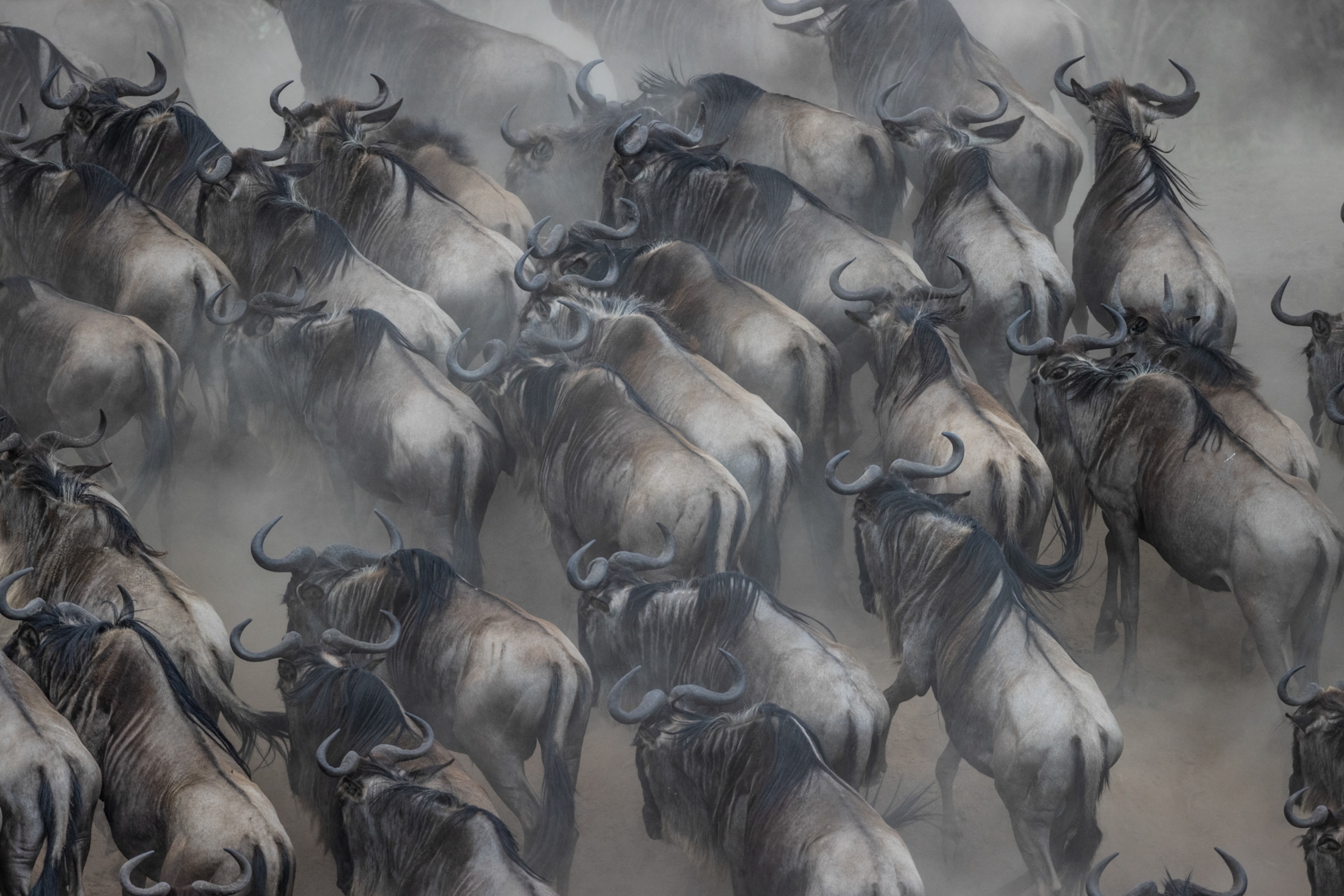
And then there’s the incessant, mind-numbing noise it makes—a combination of a croak and a moo—which prompted early African nomads to name it the “gnu” (guh-new) for the sound it made.
The result is a creature so weird but also so unassuming that when Dutch settlers first laid eyes on it, they gave it one of the least imaginative names in the animal lexicon, wild beast. So how did nature come up with this Frankenstein of the animal kingdom?
To find out, I’d called Anna Estes, an ecologist at Carleton College who works in Tanzania. “Let me stop you right there,” she said. “My dad would take it personally if anyone would impugn the wildebeest.” I called Estes because her father, wildlife biologist Richard Estes, wrote The Gnu’s World, a detailed life history of the wildebeest and a comprehensive counterargument to all the jokes. Richard, who started his research in 1962, was one of the first scientists to study the behavior of the white-bearded wildebeest of the Serengeti. Anna grew up bouncing around in a battered Land Cruiser, following the herds as her father observed them mating, giving birth, fending off predators, and yes, dying in great numbers. Her father retired a few years ago, and Estes has continued studying the ecology of the Serengeti.
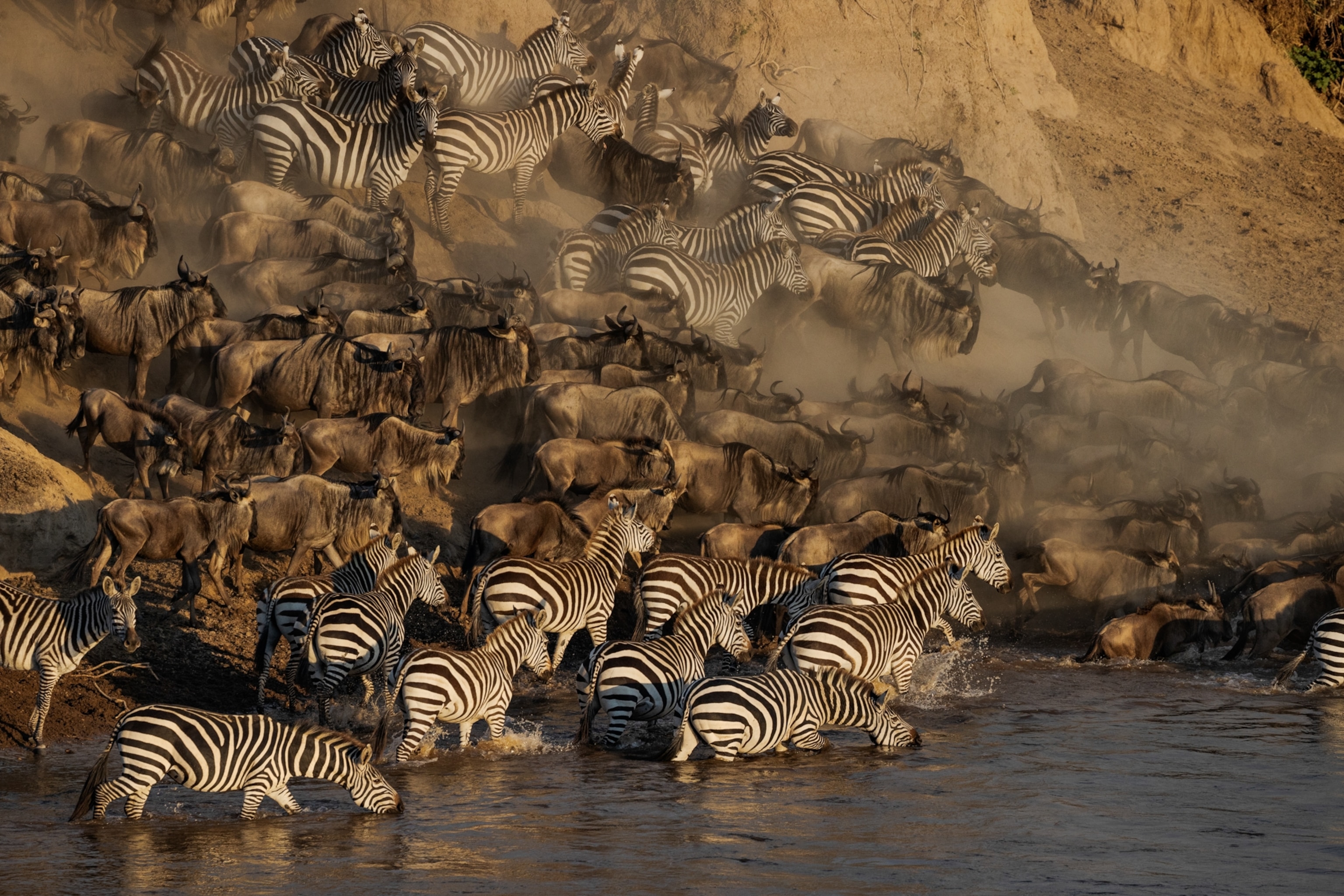
Think of it this way, she suggested: One measure of evolutionary success is population. In this sense, the wildebeest, at upwards of 1.3 million, is by far the most triumphant large mammal in the Serengeti. Elephants, with their vaunted intelligence and unchallenged brawn, number only around 8,500; lions, the so-called kings of the plain, a paltry 3,000. The closest competitors are Thomson’s gazelles and zebras—at a few hundred thousand each—and both, by the way, follow the wildebeest.
This success, she noted, is directly connected to their strange-looking body parts, which are adaptations that have been finely tuned over a million years to help them cover enormous distances and take full advantage of the unique Serengeti ecosystem. The small horns—puny compared with the African buffalo’s massive horn helmets—mean less weight to carry while walking long distances or swimming across rivers, and they’re less likely to get tangled in dense brush. The flat muzzles allow lawnmower-like grazing. The sloping backside actually promotes a highly efficient gait, and their ankles have a pogo stick–like elasticity that allows them to bounce when they run—both help save energy during the long migration. And clumsy looking or not, they can accelerate to 50 miles an hour, fast enough to elude hyenas and outpace lions. They also are very good at sensing where rain is falling and heading in the direction of distant thunderstorms, which by the time the herd arrives will have produced new grass.
But the most impressive wildebeest adaptation is its strategy for bringing the next generation into the world. Starting in late January, herds gather on the same plains Charlie and I flew over, when they’re still lush with grass fed by seasonal rains and the nutrient-rich volcanic soil. The wildebeest, unlike many other antelope species, doesn’t hide its young, and pregnant females give birth all at once out in the open. Some 500,000 wildebeest calves are born over three weeks, roughly 24,000 a day. Seven minutes after emerging from the womb, a calf is standing, and within 24 hours it can run with its mother.
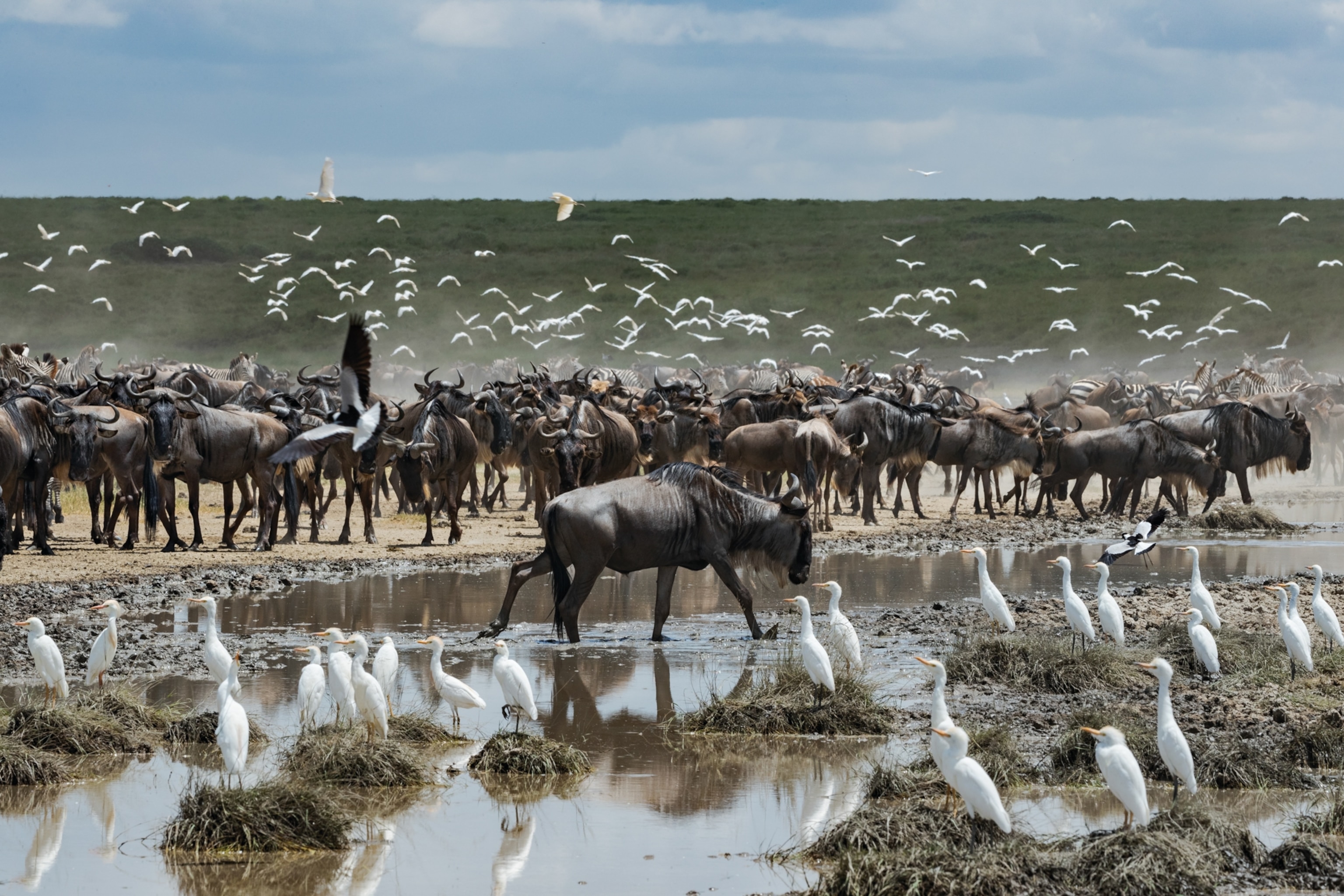
Lions, hyenas, and other predators are primed for this annual feast and glut themselves on the newborns, but they’re able to consume only a tiny fraction, and within a few weeks the calves and adults have begun to move to the next stop, their numbers swollen by nearly a third.
After speaking with Anna Estes, I went looking for other examples of ingenious wildebeest behavior.
I learned that wildebeests always give birth in broad daylight, which might seem to make them more vulnerable, except lions and hyenas generally hunt between dusk and dawn. And scent glands in their hooves leave a trail of hormones that helps the animals find their way.
Then I came across an example that put me back in the plane with Charlie, recalling the mystery of the wildebeest that seemed to strike out on its own. If a mother is separated from her calf, I learned, she’ll pull out of the column and head the opposite way—to the back of the line, where calves naturally gather when they’re lost.
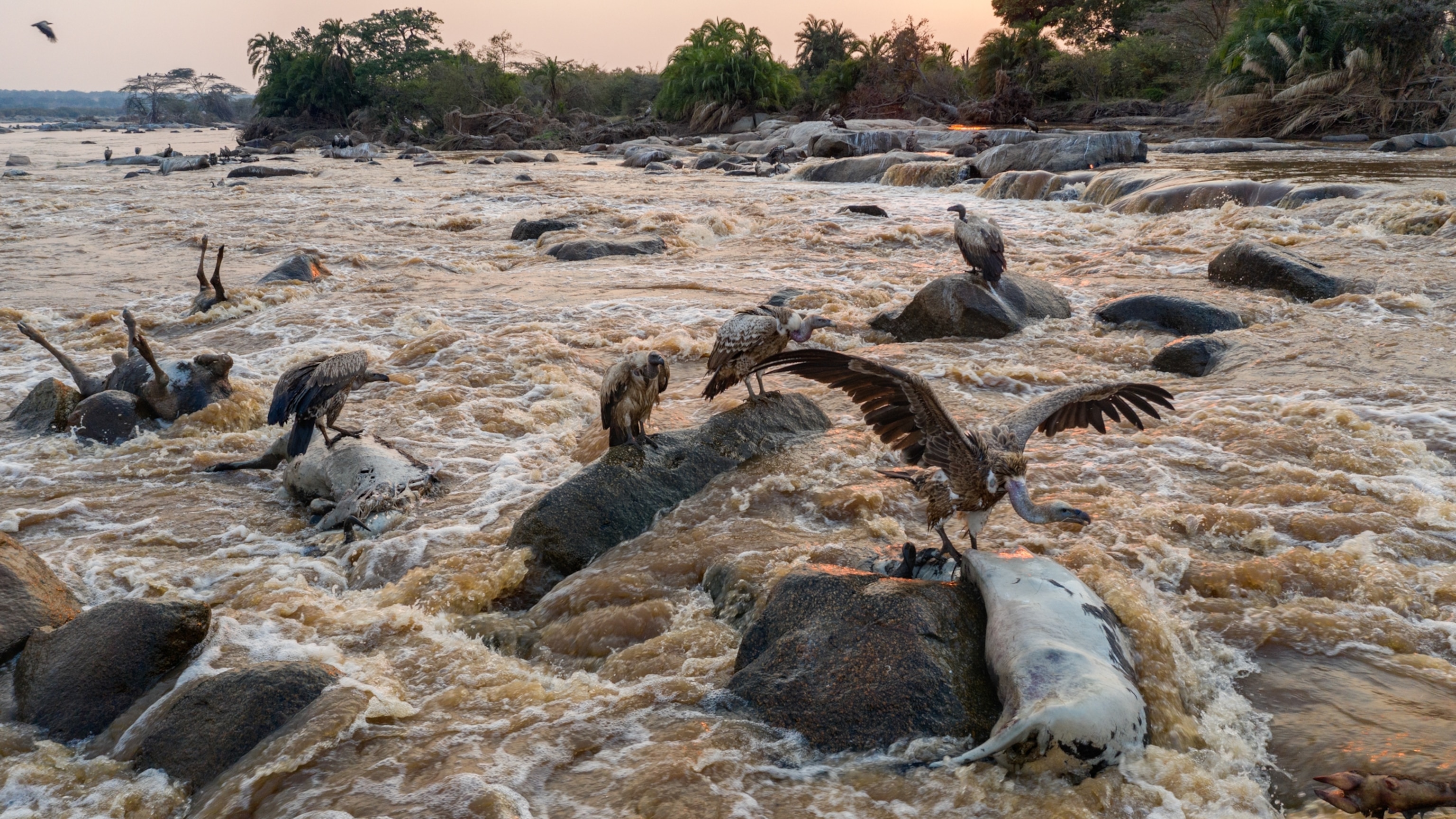
Before I left for the Serengeti, I read about a young ecologist who forever changed the way scientists view the wildebeest. Tony Sinclair had grown up in Tanzania, studied zoology at Oxford, and then spent more than a decade counting the Serengeti’s animal populations. In April 1982 he’d traveled to South Africa for a gathering of conservationists in Pretoria, where he’d taken the podium to announce astonishing news: He and another ecologist, Mike Norton-Griffiths, had counted the largest ungulate herd ever recorded.
The feat of accurately calculating the size of such a large migratory herd—before the use of satellites and other advanced technology—was impressive enough, but even more stunning was that this herd was the Serengeti’s wildebeest population.
Beginning in the 1890s, the wildebeest had been decimated by outbreaks of a virus known as rinderpest, which is related to the measles virus. Though it’s harmless to humans, rinderpest is lethal to domestic cattle and their wild cousins, including the African buffalo and wildebeest.
An effective vaccine had been widely administered by the early 1960s, stopping the outbreaks among cattle, and the wildebeest was rebounding with astounding speed. Before the vaccine largely wiped out rinderpest, the Serengeti’s wildebeest population was roughly 260,000. But in just 17 years, from 1961 to 1977, it had more than quintupled, to 1.4 million. Sinclair showed me a black-and-white photo he’d taken during one of his counting flights. A massive herd of wildebeests covers the land from horizon to horizon.
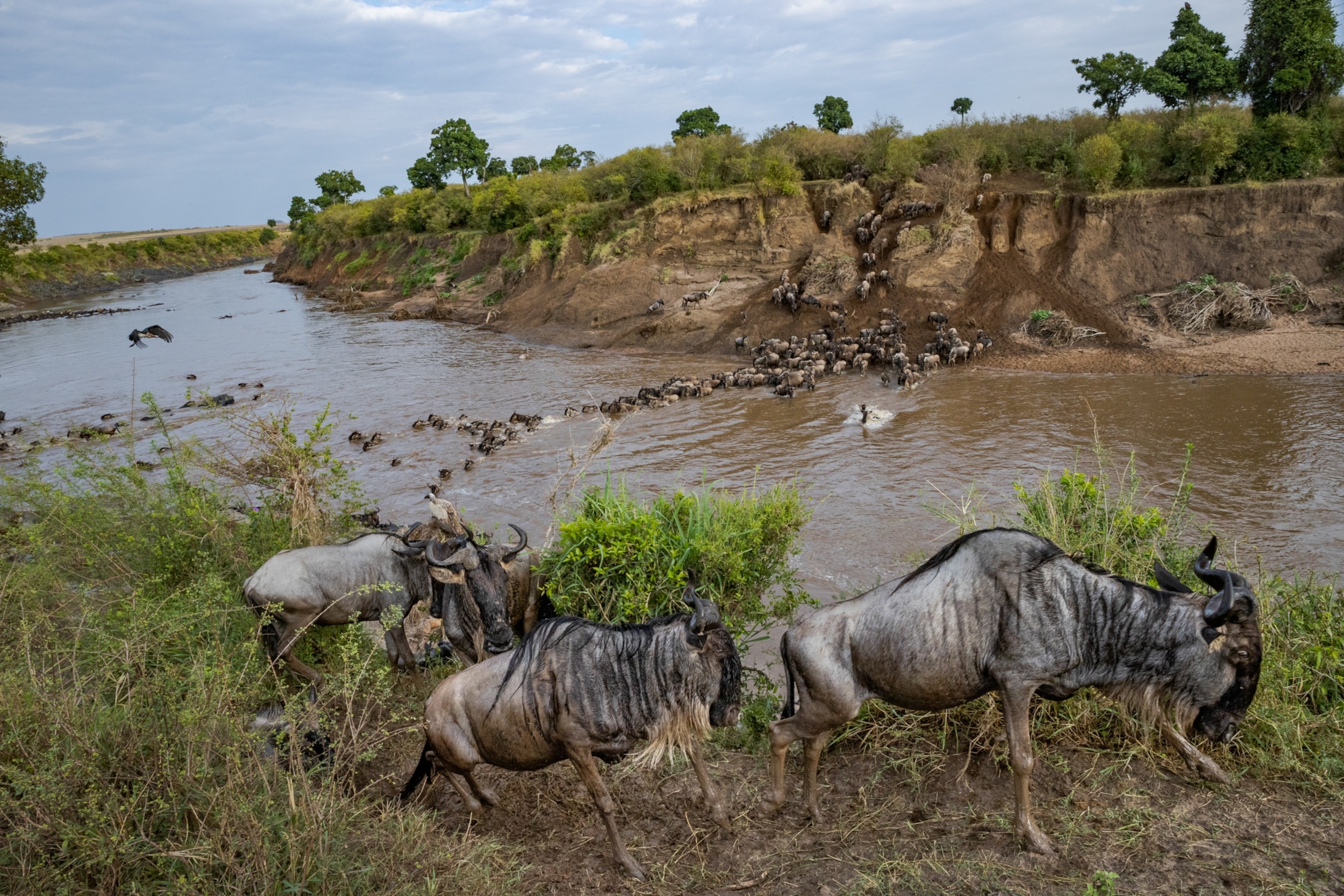
But in Pretoria, his fellow scientists didn’t share his enthusiasm. “What I got was people standing up saying, ‘This is the most irresponsible thing I’ve ever heard,’ ” he recounted when we chatted over Zoom. “ ‘What we should be doing is killing half the population.’ ”
That was the prevailing dogma held by many scientists in Africa but also in places such as Yellowstone, he said. They believed wildlife populations needed to be manipulated to stay in balance. “They had to be controlled,” he told me, explaining this thinking. “Otherwise they would just go crazy and destroy everything.”
Sinclair wasn’t convinced. “It occurred to me that we could demonstrate why that was not the case in the Serengeti wildebeest population.”
He went back to the Serengeti, and over the next several years, he and his colleagues began to notice significant changes. The first was that predator populations were growing. This wasn’t all that surprising—more prey meant more food for lions, hyenas, cheetahs, and leopards. But Norton-Griffiths also noticed that there were fewer fires. He and Sinclair figured out that the large wildebeest herd was keeping the grass shorter, so fires didn’t burn as frequently or as hot, which allowed trees to grow. Suddenly, large areas that had been grassland for nearly a century were being reforested.
More trees meant more insects, more birds, and more animals that eat the leaves of trees, including giraffes and elephants. And as the wildebeests traveled, they spread their dung, improving the soils and producing more grass for themselves and other species. Elephant populations grew, butterflies proliferated, even lowly dung beetle species flourished.
Sinclair realized the Serengeti was being transformed into a place that few, if any, living humans could remember. And the driver for this change was the humble wildebeest. At the time, the concept of a keystone species—an animal that was singularly crucial to the structure and health of an ecosystem—was relatively new. Until then, all the identified keystone species had been top predators. But in the Serengeti, the lion wasn’t king; its prey was.
To put it bluntly, Sinclair told me, “there’s no Serengeti, at least not one we’d recognize, without the wildebeest.”
Imagine the animal is writing a diary every day. ‘I’m pregnant. I’m hungry. I’m stressed.’ It’s telling you that information.
Ecologist Grant Hopcraft
As I drove across the plains, even when I saw no wildebeests, I often spotted their remains—clusters of bleached ribs, disarticulated vertebrae, and stark alabaster leg bones—each identifiable by a nearby skull adorned with the telltale horns.
I’d heard that one of Sinclair’s protégés, Grant Hopcraft, an ecologist at the University of Glasgow, was studying wildebeest remains—sort of a CSI: Serengeti. So I called him up.
I’d assumed most of these were kills, but Hopcraft discounted that notion. “People think of wildebeests dying from lions, hyenas, or crocodiles, things like that,” he said. “But predators account for only about 25 to 30 percent of the deaths among adults.” The number one cause of death? Starvation.
Hopcraft and his team study wildebeest bones, especially femurs, the large bones in the upper hind legs. “One of the things we do is look at the bone marrow content,” he said, explaining that even after death it still holds the animal’s last reserve of fat.
If the fat content in the marrow is depleted, it tells him that the animal had metabolized all the energy stored in the layers of fat under its skin and around its organs, even some of its muscle tissue, and had finally dipped into the emergency reserves in its bones. At that point, he said, “these animals are what we call a carcass with a pulse.” A predator may have delivered the death blow, but only because the animal already was weakened by starvation.
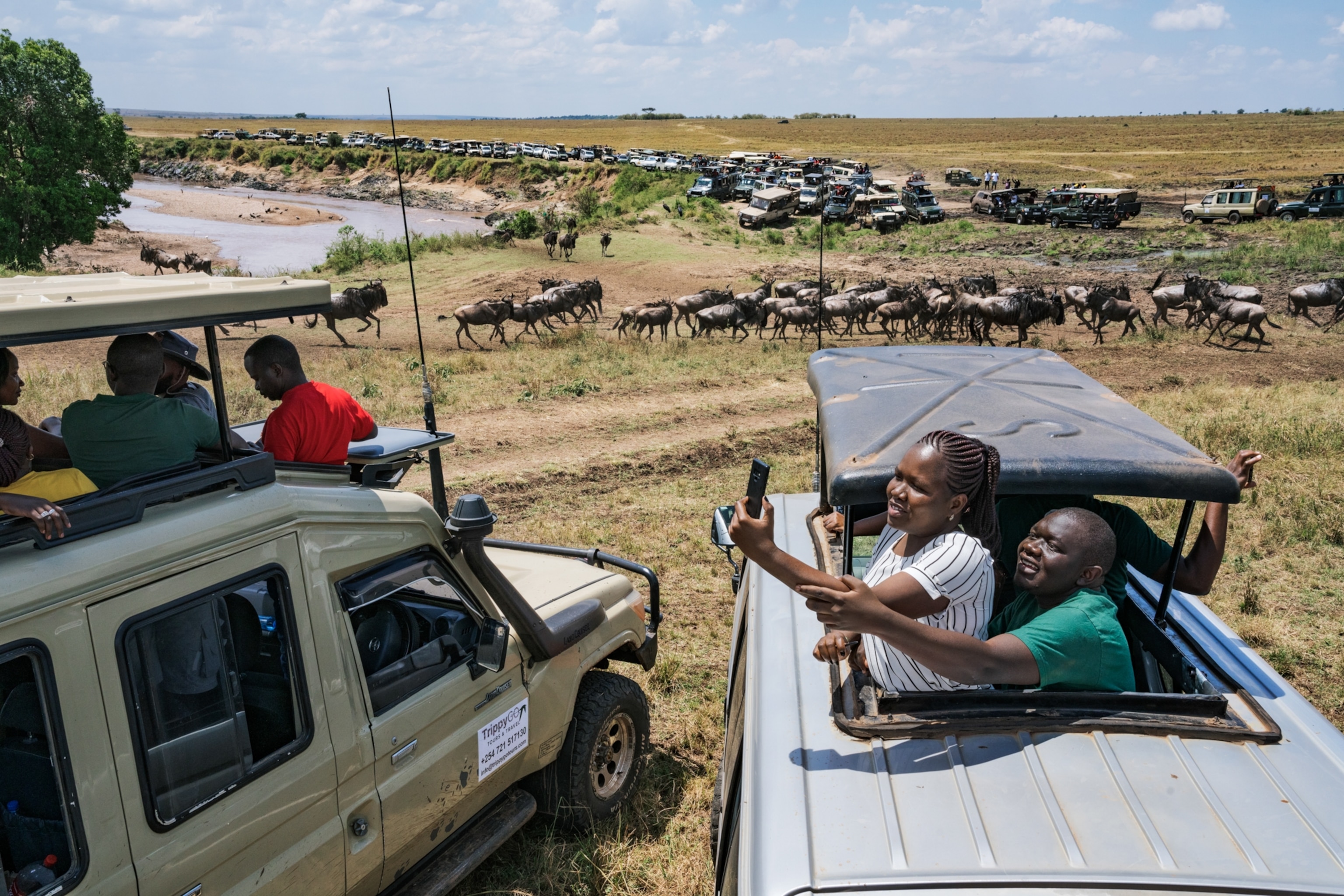
Hopcraft’s team is also studying the hairs from a wildebeest’s tail. The hairs, roughly a foot long, tell the story of the past year and a half of the animal’s life. Scientists slice them into tiny segments representing about two weeks’ growth each, then analyze them for isotopes and hormones that reveal a wealth of data about the individual. “Imagine the animal is writing a diary every day,” Hopcraft said. “ ‘I’m pregnant. I’m hungry. I’m stressed. This is where I’ve been eating. This is what I’ve been eating.’ It’s telling you that information.”
And what do these wildebeest diaries reveal? The animals are always desperately hungry, especially the females. “A female wildebeest is on the edge of starvation almost its entire life,” Hopcraft said. “And that’s because they never stop reproducing.”
He explained that the females are either pregnant or nursing a calf year-round, and for four months, from June to September, they’re doing both, all while migrating, which puts huge energy demands on their bodies. “That makes them completely focused on consuming as much as possible of the most nutritious grasses until they’re gone,” he said. Then they have to immediately figure out where the rain is falling, hurry three or four miles to the next available grazing, and start eating, competing with the million other wildebeests doing the exact same thing. “This is the engine of the migration.”
I was reminded of the wildebeest that Charlie had seen run the Mara River gantlet twice in one day and asked Hopcraft if hunger would prompt an animal to ignore such obvious threats. “It could,” he said. “Avoiding predators shapes some of their behaviors, but starvation is the dominant force.”
Many years ago, I booked a budget safari out of Nairobi, and in less than an hour we found ourselves amid a herd of wildebeests, framed against the city’s skyline. The air smelled of their pungent dung and was filled with their perpetual gnu-ing. The guide explained that this herd of some 20,000 would migrate to the neighboring Athi-Kaputiei Plains and back again. It was a miniature version of the great Serengeti-Mara migration, which circulated farther to the southwest.
I mentioned this to Joseph Ogutu, and he nodded ruefully. It was late in Nairobi when we connected on Zoom, and he pushed up his glasses and rubbed his eyes with the weariness of a man who spends his days sorting through data that tell a disturbing story. Ogutu, born and raised in western Kenya, is a senior statistician at the University of Hohenheim in Stuttgart, Germany; his specialty is counting Kenya’s wildlife populations and modeling how they change over time.
He knows the story of the Athi-Kaputiei herd all too well. In the early 2000s he began reconstructing the Kenyan government’s data sets for these wildebeests. “The government had actually done a good job collecting data,” he said. But it was scattered among old computer tapes, floppy disks, hard drives, and documents locked in filing cabinets with missing keys.
As he recovered the information and compared it with current figures, a distressing picture emerged: The migration had collapsed. The herd had dwindled from roughly 30,000 in the mid-1970s to fewer than 3,000 in 2014. The cause was attributed to a range of human activities—Nairobi’s sprawl, more fenced farms, expanding railroads, among them. Eventually, these encroachments choked the routes the wildebeests needed to find enough grazing to maintain their numbers. Without the ability to move freely, the remaining wildebeests stopped migrating.
Ogutu told me many of the same hindrances are now squeezing the Serengeti migration as it moves through the Masai Mara. As he listed these—more sheep and goat herds, more fences in Maasai communities, more water siphoned by farms—I pictured a cardiologist reviewing an MRI that revealed blockages in a patient’s circulatory system and calculating how much longer the heart would keep beating. The number of wildebeests coming into Kenya is declining, Ogutu said. “Those that do come are spending up to one and a half months fewer per year in the Mara than they used to.”
If they stopped coming, it would dramatically alter the ecosystem but also the Kenyan economy, since thousands of foreign tourists come to the Mara to watch the spectacle.
I asked Ogutu if he thought the trend was reversible. “The signals from the data that I have seen and the predictions into the future do not offer much hope for optimism,” he said, “unless we can put land aside and protect it in perpetuity for wildebeest.”
One of the last days I was in the Mara, Charlie, Ekai, and I were driving through the savanna when we spotted a young wildebeest by itself, galloping along the road. Nothing seemed to be chasing it. It was just running alone—odd behavior for a wildebeest. We caught up to it and drove alongside for a bit. It ignored us, its head bobbing up and down, small eyes focused on the road ahead. Where was this animal going? What was it thinking? At the time I thought for sure it was doomed, but now I can only wonder.
Learn more. See related educational resources about this topic—click here to access the National Geographic Society Resource Library for educators, students and lifelong learners.
On staff since 2003, Peter Gwin is an editor at large and co-host of Overheard at National Geographic.
This story appears in the December 2021 issue of National Geographic magazine.



